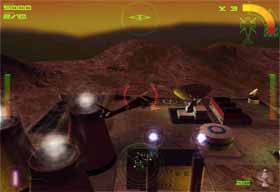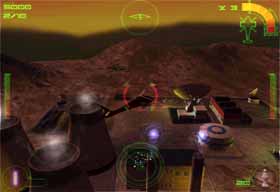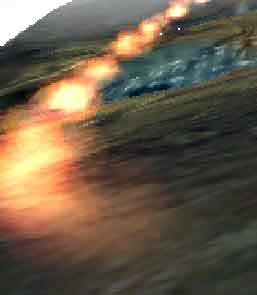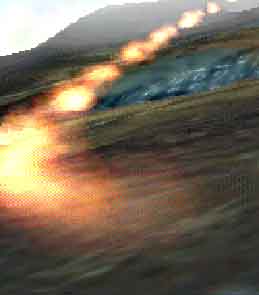
Original Link: https://www.anandtech.com/show/181
| The king of 2D enters the world of 3D gaming, a sort of "boy meets world" in terms of graphics accelerators and definitely a memorable moment in the history of one particular Canadian based video card manufacturer. |  |
For the past few years, like another well known giant in the 2D video world, Matrox has been fairly productive on the 2D end of things while virtually ignoring the rapidly developing 3D gaming arena.
Matrox had an instant success with the release of their 2D wonder child, the Millennium. Matrox's flagship 2D card evolved into a much more professional and elegant 2D solution, even dipping its dry fingers into the 3D pool with relatively limited 3D support provided for by its successor the Millennium II.
At the same time Matrox was conquering the 2D market uncontested companies such as 3Dfx and nVidia were experimenting in unexplored waters with their Voodoo and Riva 128 based 3D solutions. In order to say that they have made an attempt at the 3D market, Matrox decided to appeal to the gaming community by releasing a home entertainment version of their Millennium with increased 3D support. The product? The Matrox Mystique.
The Mystique's limited success and the poor image quality Matrox's newest 3D concoction, the PowerVR based m3D, brought to the table kept Matrox from growing into the potential threat they could be to the competition in the 3D market.
The Dream
A video card that could boast both excellent 2D performance and outstanding 3D support with crisp image quality in any situation the card was put in, that was the dream of many manufacturers for quite some time. Unfortunately it has taken much more than an indefinite period of time for a great percentage of those manufacturers to accomplish what they set out to do. It was about time for Matrox to give the 2D/3D combo world another try, this time with a little more effort.
The Reality
The Matrox G200 series of graphics accelerators, the reality behind the dream Matrox put all of their efforts during these past few months to make possible. Building on the same nomenclature as their original line of graphics accelerators, Matrox's latest production has been divided into two main categories: the Matrox Millennium G200 and the Matrox Mystique G200.
As the name implies, the Millennium G200 is geared towards high end users and professionals - basically anyone who isn't bothered by the lack of a TV-Output feature. Using a 250MHz RAMDAC and high speed SGRAM the Millennium G200 picks up where the Millennium II left off adding actual 3D support to an already beautiful 2D feature set.
No longer being associated with "crap" among hard core gamers, the Mystique G200 is essentially the same card as the Millennium G200 with a few modifications. Primarily, the Mystique features a 230MHz RAMDAC and uses lower cost SDRAM instead of the SGRAM found on its Millennium counterpart. The performance difference between the two cards will probably be negligible at most with the largest gaps forming in 2D performance. What the Mystique G200 offers that its professional looking brother can't provide is 1024 x 768 TV-Output that gamers will utterly fall in love with.
That being said, let's see how well Matrox measures up to the high expectations of the maturing market around them as AnandTech takes a closer look at the newly released Matrox Mystique G200 AGP Graphics Accelerator.
Click here to find lowest prices on this product.
General Specifications
- 230MHz Integrated RAMDAC
- 8MB SDRAM Upgradable to 16MB
- Full AGP 2X Support
- 128-DualBus Architecture (Dual 64-bit Independent Buses)
- Dual Command Pipelining
- 32-bpp True Color Rendering & Z-Buffering
- Per Pixel Trilinear Filtering
Advanced 3D Feature Set
- Alpha-Blending
- Bi-linear Filtering
- Tri-linear MIP-Mapping
- Fogging
- Anti-Aliasing
- Specular Highlighting
3D Graphics Performance
- 1.5M triangles/second
- 100M pixels/second
Supported Display Modes
Matrox Mystique G200 8MB AGP |
||||
| - | Colors | Refresh Rate | ||
Resolution |
2D | 3D | Verticle (Hz) | Horizontal (KHz) |
| 1920x1200 | 16M | --- | 60-70 | 75-91 |
| 1800x1440 | 16M | --- | 60-65 | 89-97 |
| 1600x1200 | 16M | 65K | 60-85 | 75-106 |
| 1280x1024 | 16M | 16M | 60-100 | 64-107 |
| 1152x864 | 16M | 16M | 60-120 | 54-110 |
| 1024x768 | 16M | 16M | 60-140 | 48-113 |
| 800x600 | 16M | 16M | 60-200 | 38-114 |
| 640x480 | 16M | 16M | 60-200 | 31-102 |
Supported Operating Systems
- Microsoft Windows (95 or higher)
- Microsoft Windows NT (4.0 or higher)
Supported Graphics APIs
- Direct3D
- OpenGL
Click here to find lowest prices on this product.
To fully understand where the performance and image quality come from when looking at a video card such as the Mystique G200, we must turn our attention to the heart of the card, the chipset - in this case, the Matrox G200.
128-bit DualBus
Imagine that you are on an 8-lane highway. The 8-lanes of this highway allow for more traffic to move from one end of it to the other, however there is a catch. The cars on the highway can only be moving in one direction at a time, meaning that all the cars must either be moving up the highway or down it but not both at the same time (all 8-lanes move in the same direction). Consider that the limited functionality of an internal 128-bit Data Bus when applied to video cards, on any given CPU clock cycle the data being transferred via the internal 128-bit Data Bus can only flow in one direction (to the graphics engine). On the following clock cycle the data can be transferred down the bus in the other direction (from the graphics engine). While this approach does have its benefits, when dealing with 2D images and bitmaps where the data that must be transferred down the bus remains quite small (less than 128-bits) there is a much more efficient way of approaching this.
Let's take that highway example from above, now instead of making that highway an 8-lane highway let's split it up into a 4-lane going and a 4-lane coming highway. Meaning that at the same time 4 lanes of cars can be traveling on the highway in the opposite direction of 4 lanes of cars on the other side of the highway (4 lanes can be leaving the city while 4 lanes can be entering). If there is no need for 8 lanes to be open for transportation in any one direction then the first 8-lane highway wouldn't be as efficient as this modified 4/4-lane highway. The same theory applies to the Matrox G200.
Instead of occupying the entire width of a 128-bit bus to transfer data in 64-bit chunks why not create a dual 64-bit setup with one bus dedicated to sending data to the graphics engine and the other dedicated to receiving data from it. This is what the G200's 128-bit DualBus architecture is, in essence it is 2 64-bit buses offering the same combined bandwidth as a single 128bit data bus while allowing for data to be sent in parallel to and from the graphics engine. It is this technology that gives the G200 the edge over the competition in its 2D performance, allowing for 24-bit desktop color depths at a faster level of performance than most of the competition can do at 16-bit color depths.
3D Performance and Image Quality
What good is a 2D combo card without the powerful 3D punch to back up its dimension crippled counterpart in performance? The G200 doesn't lose any points here either, with a 100 million pixels/second fill rate one would expect the G200 to be able to hold its ground fairly well in 3D games and applications. You must keep in mind that the G200 was never intended to be a Voodoo2-killer rather a lower cost alternative for those who don't have the funds to accommodate a single Voodoo2 + 2D accelerator which justifies the sub-Voodoo2 levels of performance you'll be seeing from the G200.
One advantage, outside of price, that the G200 holds over the Voodoo2 as well as all other 2D/3D combo cards is its top notch image quality. Using Vibrant Color Quality (VCQ) Rendering the G200 is capable of rendering images in 32-bits per pixel color (meaning 8-bits for red, green, blue and alpha) even if the rendering is set to 16-bpp the internal calculations and accuracy is done in 32-bpp and dithered down to 16-bpp upon displaying the images. Matrox illustrated this difference quite nicely on their VCQ Whitepaper which is summarized beautifully by the two screenshots they provided below:
|
|
The difference is clearly noticable in the 32-bit Rendered Incoming screenshot, whether or not this will mean anything to you as the frames are flying past you while playing is up to you to decide, however once you experience the G200's image quality you'll never want to go back.
Another excellent example Matrox used was the following screenshot comparison of a 32-bit texture rendered in both 32-bits and 16-bits to visually illustrate the difference between the G200 and a chipset only capable of 16-bit Rendering in a 32-bit scenario.
|
|
As more and more games begin to use 32-bit textures you can expect to notice differences like the one illustrated above between a graphics card capable of 32-bit rendering and one limited to 16-bit rendering. Since the number of games that make use of 32-bit textures is extremely low this feature doesn't carry as much weight as performance does, for example. But for now you can rest assured knowing that one day you'll be able to make more use of the G200's advanced rendering capabilities - better safe than dithered in this case.
Click here to find lowest prices on this product.
| The new, more professional looking box the Mystique G200 came in is virtually identical to that of Matrox's intermission video card release, the Productiva G100. AnandTech received a Mystique G200 equipped with 8MB of SDRAM on-board which can be upgraded to 16MB using the memory expansion slot located on the board itself. | 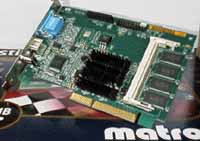 |
Unpacking the cleanly designed box brought back memories of opening up the original Millennium what seemed like ages ago. Enclosed in a plastic casing was the Matrox User's Manual, 2 CD's, a set of 4 installation disks (yep, disks), and the Mystique G200 board itself.
Before getting to the board, it is necessary to point out that Matrox is one of the few video card manufacturers left that actually provides written documentation with their products. While you can't expect to find a 50-page motherboard manual in every G200 box, the Mystique G200's written documentation is among the best AnandTech has encountered with a video card. The manual provides clear diagrams explaining the installation process, as well as the physical differences between a PCI and an AGP slot. For you advanced users out there you won't have to worry at all about the quality of the User's Manual, however not everyone has had that much experience with upgrading which is where Matrox's reliable manual comes into play. The only bad thing that can be said about the documentation is that it is obviously the "one size fits all" type of documentation, meaning the same manual that is shipped with the Mystique G200 is also present in the Productiva G100 packages which can be confusing/annoying at times.
Bundled with the Mystique G200 were copies of Motorhead, Incoming, and Tonic Trouble. A decent bundle at the least, however for a card like this you would expect at least one Quake-style first person shooter. The Millennium G200 differs from the Mystique here in that its software bundle is composed of Picture Publisher, Simply 3D, Netscape Communicator, and PointCast Client instead of the three game titles mentioned above. Matrox provided the latest drivers for the G200 on CD while also providing an older set of drivers on 3 of the 4 disks. The latest revision of the drivers were used in the AnandTech G200 tests as well as the drivers on the 4th disk. The 4th disk contained an OpenGL D3D Wrapper which is nothing more than a translator which intercepts OpenGL instructions and sends them to the video card in the form of Direct3D instructions. This is a temporary solution to provide OpenGL (i.e. Quake 2) support for G200 owners until a full Installable Client Driver is made available to the public which should be in another month or two. Naturally an D3D wrapper won't provide you with the best possible performance, but it is nice to know that one was included for Quake 2 fanatics. Don't think that you'll be able to make use of the D3D Wrapper straight out of the box since it requires DirectX 6.0, something that has yet to be made available to the public. So in actuality the Mystique G200, as it is shipping now, ships with absolutely no OpenGL support out of the box. Something which will (must) hopefully change in the coming months.
The Mystique G200 board itself looks very much like a Riva 128/i740 hybrid because of the length of the board (Riva 128) and the massive heatsink on the G200 chipset (i740). The 4 - 2MB SDRAM chips line the outer edge of the PCB and are surrounded by the SO-DIMM SDRAM memory expansion slot. There are two feature connectors on the Mystique G200 board for future expansion and upgradability to Video Capture and Hardware DVD Decoder products from Matrox. Future support for an add-on DVD decoder is a definite plus especially with DVD drives growing in popularity and DVD movie titles undergoing a rapid expansion process.
| Sticking the G200 in an open AGP slot on the AnandTech Pentium II-BX test system (ABIT BX6), a clean install of Windows 98 was performed without a hitch. Windows 98 prompted for a drivers disk for the display adapter, and using the G200 Installation CD a new item was present under the Windows 98 Control Panel entitled Matrox Display Properties. The Matrox Display Properties Control Panel is dedicated to the functions of the G200 allowing for manipulations of the desktop resolution/color depth as well as more advanced features like allowing users the ability to turn of Bus Mastering for compatibility issues if they arise. | 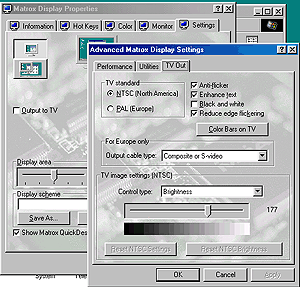 |
| The new control panel also allows you to enable the 1024 x 768 TV-Output features of the Mystique G200 which surpass even the Canopus cards in terms of visual quality. While the TV-Out still can't compare to the quality of a sharp 21" screen, for games it isn't that bad of a solution. Just don't expect to be able to type up your documents on your TV screen as small text is often too difficult to make out due to the lower resolution of NTSC/PAL TV screens. | |
The installation process flew by equally as smoothly on the two Super7 test systems AnandTech used with the G200. The Iwill XA100 based on the ALi Aladdin V chipset was the test board for the Super7 tests with the G200, while the California Graphics Photon 100 HC using the VIA MVP3 Chipset (Revision CD) also managed to install the G200 without a single problem. Meaning that the compatibility issues rumored to be present between the G200 and Super7 systems, regardless of chipset, are false as the G200 performed equally as well on the Aladdin V as it did on the MVP3 and on both chipsets the card was rock solid, never flinching even once. Just be sure to grab the latest AGP VxD drivers from your chipset manufacturer if you are using anything other than an Intel LX or BX based motherboard.
A quick reboot and the desktop resolution was set at 1024 x 768 x 16-bit color, ready for the suite of tests that were about to be thrust upon the infant card. So without further ado, let's take a look at how well this little infant matured in the AnandTech Performance Tests...
Click here to find lowest prices on this product.
The Slot-1 Pentium II Test System AnandTech used was configured as follows:
Intel Pentium II 400 on an ABIT BX6 Motherboard
64MB PC100 SDRAM
Western Digital 5.1GB Ultra ATA Hard Drive
AOpen 32X IDE CD-ROM Drive
Windows 98 with all of the latest patches/drivers installed
The Super7 Test System AnandTech used was configured as follows:
AMD K6-2/300, Cyrix M-II 300, Intel Pentium MMX 233 on an Iwill XA-100 Motherboard
64MB PC100 SDRAM
Western Digital 5.1GB Ultra ATA Hard Drive
AOpen 32X IDE CD-ROM Drive
Windows 98 with all of the latest patches/drivers installed
The benchmark suite consisted of the following full version game titles
Forsaken - Running the Nuke Demo
Turok Dinosaur Hunter run with the '-benchmark' option
Quake 2 v3.14 using Demo1.dm2 and Brett "3 Fingers" Jacobs Crusher.dm2 demo
Ziff Davis' Winbench 98 was also used to test 2D performance
VSYNC was disabled during AnandTech's tests and was done so by using the following procedure:
Using the Windows 98 Registry Editor click on HKEY_LOCAL_MACHINE, then Software, then Matrox, then Current Settings and add the following string value with a value of 0 (use a value of 1 to enable VSync): Flip On Vblank
Thanks to Craig from AnandTech Network Affiliate Cyrellis for pointing that out to me.
Ziff Davis Winbench 98 - 2D Performance |
||
| - | Business | High End |
| - | Windows 98 - P2 400 | Windows 98 - P2 400 |
| G460 i740 8MB | 206 | 274 |
| Matrox G200 8MB | 207 | 269 |
| Riva TNT 16MB | 216 | 263 |
Pentium II Test System - Quake 2 - Open GL Performance |
||
| - | Timedemo - 640 x 480 | |
| - | demo1.dm2 | crusher.dm2 |
| G200 Pentium II - 233 | 32.3 | 17.9 |
| G200 Pentium II - 333 | 39.2 | 24.3 |
| G200 Pentium II - 400 | 41.3 | 28.3 |
| - | Timedemo - 800 x 600 | |
| - | demo1.dm2 | crusher.dm2 |
| G200 Pentium II - 233 | 26.4 | 17.2 |
| G200 Pentium II - 333 | 28.4 | 21.6 |
| G200 Pentium II - 400 | 29.0 | 23.3 |
| - | Timedemo - 1024 x 768 | |
| - | demo1.dm2 | crusher.dm2 |
| G200 Pentium II - 233 | 17.4 | 14.1 |
| G200 Pentium II - 333 | 17.9 | 15.4 |
| G200 Pentium II - 400 | 18.1 | 15.8 |
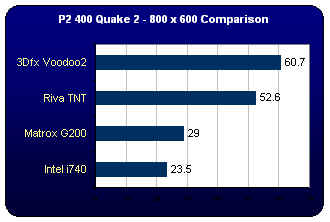
As you can tell, on the high end of things the G200 isn't the world's best Quake 2
competitor courtesy of the slow D3D Wrapper that was provided with the card. Once
the OpenGL ICD is released expend that G200 bar to come within 10 fps of the RivaTNT's
performance under Quake 2.
| Just edging out the i740 in terms of performance (not to mention image quality), the Pentium II 233 scores reveal that the G200's performance isn't all that bad in comparison to the TNT and especially not the i740 on the low end. If you're looking for the worst case scenario benchmarks under Quake 2, then the Crusher.dm2 scores provide just that as they give you an impression of how poorly the card can perform. | 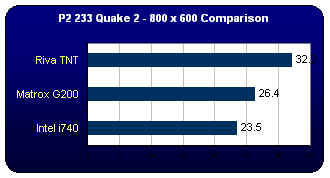 |
Pentium II Test System - Forsaken - Direct3D Performance |
|
| - | Frame Rate - 640 x 480 |
| - | Nuke Demo |
| G200 Pentium II - 233 | 90.29 |
| G200 Pentium II - 333 | 101.59 |
| G200 Pentium II - 400 | 105.32 |
| - | Frame Rate - 800 x 600 |
| Nuke Demo | |
| G200 Pentium II - 233 | 66.80 |
| G200 Pentium II - 333 | 71.78 |
| G200 Pentium II - 400 | 74.6 |
| - | Frame Rate - 1024 x 768 |
| Nuke Demo | |
| G200 Pentium II - 233 | 43.05 |
| G200 Pentium II - 333 | 45.13 |
| G200 Pentium II - 400 | 46.37 |
| In Direct3D the G200 is starting to give the Voodoo2 and the Riva TNT a run for the money, especially considering the $130 - $150 price range of the 8MB G200 and the superb image quality. | 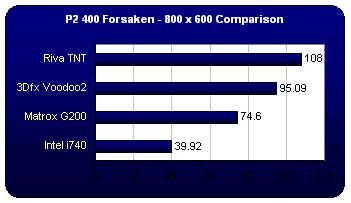 |
Pentium II Test System - Turok - Direct3D Performance |
|
| - | Frame Rate - 640 x 480 |
| - | TMark |
| G200 Pentium II - 233 | 69.1 |
| G200 Pentium II - 333 | 93.0 |
| G200 Pentium II - 400 | 107.0 |
| - | Frame Rate - 800 x 600 |
| - | TMark |
| G200 Pentium II - 233 | 66.5 |
| G200 Pentium II - 333 | 88.2 |
| G200 Pentium II - 400 | 99.7 |
Click here to find lowest prices on this product.
Super7 Test System - Quake 2 - Open GL Performance |
||
| - | Timedemo - 640 x 480 | |
| - | demo1.dm2 | crusher.dm2 |
| AMD K6-2 300/100 | 21.8 | 12.5 |
| AMD K6-2 300/66 | 20.0 | 11.4 |
| Cyrix M-II 300 (233/66) | 15.4 | 8.4 |
| - | Timedemo - 800 x 600 | |
| - | demo1.dm2 | crusher.dm2 |
| AMD K6-2 300/100 | 18.4 | 11.4 |
| AMD K6-2 300/66 | 17.2 | 10.5 |
| Cyrix M-II 300 (233/66) | 13.8 | 7.9 |
| - | Timedemo - 1024 x 768 | |
| - | demo1.dm2 | crusher.dm2 |
| AMD K6-2 300/100 | 14.2 | 9.3 |
| AMD K6-2 300/66 | 13.5 | 8.8 |
| Cyrix M-II 300 (233/66) | 11.3 | 6.9 |
The G200/Super7 benchmarks using the D3D Wrapper for Quake 2 are just too low to be compared to any other cards out right now. Hopefully things will change by the time the Full ICD is released in the coming months, but for now, Super7 owners shouldn't plan on having too much fun under Quake 2.
Super7 Test System - Turok - Direct3D Performance |
|
| - | Frame Rate - 640 x 480 |
| - | TMark |
| AMD K6-2 300/100 | 32.9 |
| AMD K6-2 300/66 | 30.8 |
| Cyrix M-II 300 (233/66) | 28.0 |
| Intel Pentium MMX 233 | 30.2 |
| - | Frame Rate - 800 x 600 |
| - | TMark |
| AMD K6-2 300/100 | 30.0 |
| AMD K6-2 300/66 | 27.3 |
| Cyrix M-II 300 (233/66) | 25.2 |
| Intel Pentium MMX 233 | 26.9 |
Not the ideal Super7 video card, K6-2 owners will probably want to shell out the extra bucks for a Voodoo2 however in comparison to cards in its price-range the G200 is still a great deal for the cost considering the image quality and average performance you'll receive on a Super7 system. Not to mention that the G200 doesn't seem to have any incompatibilities with either of the Super7 chipsets out currently, making it one of the best, if not the best, AGP 2X Video Card for a Super7 system.
Click here to find lowest prices on this product.
As a Voodoo2-killer, the Mystique G200 is a failure, however since it was never intended to be a Voodoo2-killer then the success of the G200 is much more than originally expected. The hard core gamer will probably want to wait for a Savage3D or a Riva TNT, however for an average gamer without an immense budget the G200 takes the place of the i740 as the ideal 2D/3D combo chipset.
The image quality on the G200 is top notch, unparalleled by any card currently available and its Pentium II/Celeron performance is excellent offering the best of both worlds to those with $150 left in their wallets. What the market never thought possible finally happened, the boy meets world scenario took place and immediately ended with a positive result. It looks like Matrox and 3D Gaming was a match that was meant to be.
Matrox tried their hand at the 2D/3D combo market once again and this time emerged victorious. Matrox emerged not with the title of world's fastest performer, not with the widely sought Voodoo2-killer name displayed on their belt, but with the feeling of success draped across their faces in the form of a smile knowing that there will be quite a few gamers out there who, for the first time, are proud to be powered by Matrox.
Matrox Mystique G200 Card
Price - $139
Website - http://www.matrox.com

